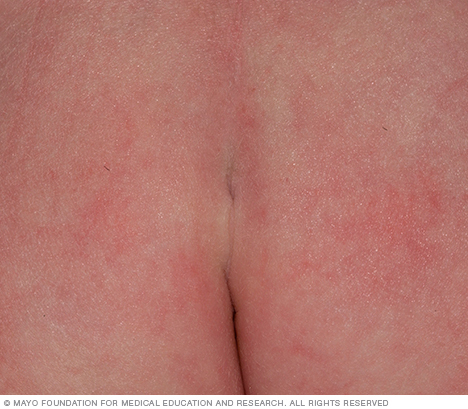Sacral dimple
Overview
A sacral dimple is an indentation or pit in the skin on the lower back that is present at birth in some babies. It's usually just above the crease between the buttocks. Most sacral dimples are harmless and don't need treatment.
A sacral dimple can be a sign of a serious spinal problem in a newborn if the dimple is large or appears near a tuft of hair, skin tag, lump or discolored area. In these instances, your child's health care provider may recommend an imaging test. If a spinal problem is found, treatment depends on the underlying cause.
Symptoms
A sacral dimple is an indentation or pit in the skin on the lower back. It's usually located just above the crease between the buttocks.

A sacral dimple is an indentation or pit in the skin on the lower back — usually just above the crease between the buttocks. Most sacral dimples are small and shallow.
Causes
There are no known causes for a sacral dimple. It is a congenital condition, meaning it's present at birth.
Complications
Rarely, sacral dimples are associated with a serious underlying abnormality of the spine or spinal cord. Examples include:
- Spina bifida. A very mild form of this condition, called spina bifida occulta, occurs when the spine doesn't close properly around the spinal cord, but the cord remains within the spinal canal. In most cases, spina bifida occulta causes no symptoms and doesn't need treatment.
- Tethered cord syndrome. The spinal cord normally hangs freely within the spinal canal. Tethered cord syndrome is a disorder that occurs when tissue attached to the spinal cord limits its movements. Signs and symptoms may include weakness or numbness in the legs and bladder or bowel incontinence.
The risks of these spinal problems increase if the sacral dimple is accompanied by a nearby tuft of hair, skin tag or lump, and certain types of skin discoloration
Diagnosis
A sacral dimple is diagnosed with a physical exam, usually during a baby's first exam. If the sacral dimple is large or appears with a nearby tuft of hair, skin tag or lump, or certain types of skin discoloration, your health care provider may suggest imaging tests to check for spinal cord problems.
These tests may include:
- Ultrasound. This noninvasive procedure uses sound waves to produce images of structures of the body.
- Magnetic resonance imaging (MRI). If more detail is needed, your health care provider may recommend an MRI, which uses radio waves and a strong magnetic field to create cross-sectional images of the body. This method requires medicine to prevent the child from moving during the scan. This is called sedation.
Treatment
Treatment is unnecessary for a simple sacral dimple.
Preparing for an appointment
In general, your child will not need to see a health care provider for a sacral dimple. If you have questions about the sacral dimple, you can also bring these up at your child's routine office visits.
Some questions you might want to ask your child's health care provider include:
- Does my child need any tests to be sure there's no other cause?
- Does the area need any special cleaning or care?
- Is any treatment necessary?
- Is a sacral dimple ever associated with more-serious conditions?
Last Updated Oct 7, 2022
© 2024 Mayo Foundation for Medical Education and Research (MFMER). All rights reserved. Terms of Use



